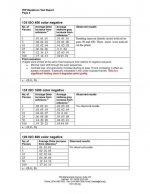Sparrow
Veteran
Actually, no I didn't write that. I didn't check my bags in. I travel light so never do.
What I actually wrote was "Note that this is x-ray damage caused by a check-in luggage x-ray check."
Full disclosure: I assume it was an x-ray check for luggage to be checked in, but to be perfectly honest, I'm not actually 100% sure to this day. Let me explain.
Third world domestic airports are not always up to first world standards, and Vientiane's domestic airport is no exception. After arriving from Bangkok and walking 200 metres or so from the international terminal building to the domestic terminal building, the first thing I wanted to do was check in for my domestic flight from Vientiane to Luang Prabang. At the entrance to the domestic terminal's check-in counter area there was an x-ray check. I assumed it was a compulsory check for all baggage including carry-on. There were no signs in English to confirm that. There was a minimal number of staff operating it though, so I could have easily walked around the x-ray check and gone directly to the check-in counter. But not wanting to cause any problems, I put my bags through. Size-wise the x-ray machine itself looked no different from the carry on luggage x-ray machines you see at major first world airports, such as at Narita for example. I then checked in but kept my bags as carry-on luggage. I then went through one more x-ray check on the way to the flight waiting area, and yet another x-ray check before boarding the flight. There was no way to avoid the second and third x-ray checks, but in retrospect I could have avoided that first x-ray check. At the time, the impression I got speaking to the girl working at the check-in counter was that the first x-ray check was for bags to be checked in. Her English wasn't great so I couldn't be 100% sure.
Sorry .. I stand corrected. I should have said damaged by a checked-in luggage scanner
... and so there is no misunderstanding
A hand baggage scanner works a bit like a contact print, radiation is passed through the bag onto a sensor to create a 2D image of the bag's content. I expect these are very low output these days probably much less than the 20 microsieverts used in a chest x-ray, that's around a third of the dose I get each year from living in a stone house, half what you get on a transatlantic flight or eating a dozen bananas
The modern checked-in scanners work by computerised tomography, (those big white things that look a bit like thay thing on Star-gate) and they create a 3D image and if they are anything like the medical ones they will be anything from 50 to 500 times more powerful, say 20 to 60 millisieverts ... I expect the exact details are not available for security reasons.
I became personally aquatinted with ionising radiation last year so I naturally did a bit of research ...


